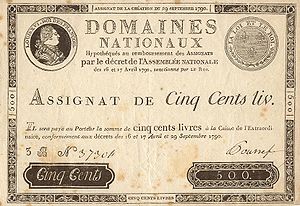Assignat was the type of a monetary instrument used during the time of the
French Revolution, and the
French Revolutionary Wars.
[edit] France

Early
Assignat of 29 Sept, 1790: 500
livres

The value of Assignats (1789-1796)

Assignat of 4 Jan 1792, still bearing Royal markings: 15
sols
Assignats were paper money issued by the
National Assembly in France from 1789 to 1796, during the
French Revolution. The assignats were issued after the confiscation of church properties in 1790 because the government was bankrupt. The government thought that the financial problems could be solved by printing certificates representing the value of church properties. These church lands became known as
biens nationaux (“national goods”). Assignats were used to successfully retire a significant portion of the
national debt as they were accepted as legitimate payment by domestic and international creditors. Certain precautions not taken concerning their excessive reissue and comingling with general currency in circulation caused hyperinflation.
Originally meant as
bonds, they evolved into a currency used as
legal tender. As there was no control over the amount to be printed, the value of the assignats exceeded that of the confiscated properties. This caused massive
hyperinflation. In the beginning of 1792, they had lost most of their nominal value. In 1796, the
Directoire issued
Mandats, a currency in the form of land warrants to replace the assignats, although these too quickly failed.
This hyperinflation was stirred up by repeated food shortages. Instead of solving the financial problems, the assignats became a catalyst for (food) riots. Instability continued after the abolition of the monarchy, exacerbated by the wars France faced. This situation impeded the implementation of good financial policies that would reduce
debts. Bills such as the
Maximum Price Act of 1793 aimed to regulate inflation.
When the
Directoire came into power in 1795 the
Maximum Price Act was lifted. Hyperinflation reemerged and in the next four years Paris was the stage of yet more riots.
The inflation was finally solved by
Napoleon in 1803 by introducing the
franc as the new currency. By this time, the assignats were basically worthless.

Italian
Assegnato: 10
Paoli
Between 1798 and 1799, the
revolutionary French forces established the
Roman Republic, which also issued
assignats (Italian:
assegnati). They were issued by the law of 23
Fructidor VI (14 Sept 1798). The currency used was
paolo or
giulio, the older
currency of the Papal States. Roman Republic also issued coins denominated in
baiocco and
scudo.
[edit] Russia
The term
assignat is similar to the Russian word
assignatsia which means "banknote".
Assignatsionny rubl (
assignation ruble) was used in Russia from 1769 until 1 January 1849. This had no connection to the French Revolution.




No comments:
Post a Comment